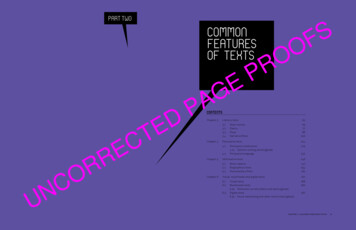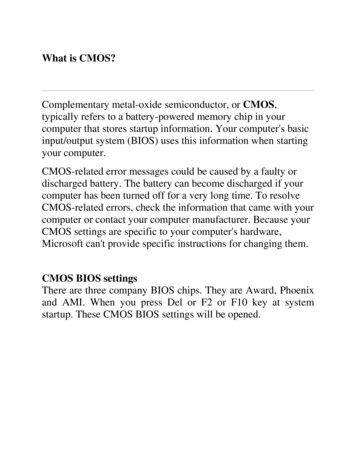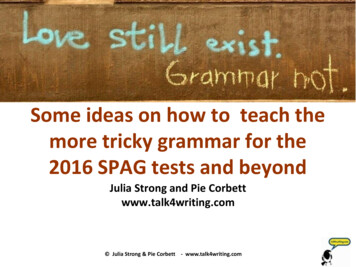
Transcription
PART TWOCommonfeaturesof textsDETCROUCNEROOSFPRPEGAContentsChapter 3Literary texts3.13.23.33.4Chapter 4Chapter 6Short storiesPoetryPlaysNarrative films637788100Persuasive texts1144.11154.2Chapter 562Persuasive media texts4.1a Opinion writing online (obook)Persuasive language130Informative texts1465.15.25.3147154161News reportsBiographical textsDocumentary filmsVisual, multimodal and digital texts1676.16.21681806.3Visual textsMultimodal texts6.2a Television current affairs and satire (obook)Digital texts6.3a Social networking and other online texts (obook)187chapter 1: analysing persuasive texts61
Unit 3.1Chapter 3OONovels andshort storiesliterarytexts David Malouf’s novel RansomHarper Lee’s novel To Kill a MockingbirdJane Austen’s novel Pride and PrejudiceCharles Dickens’s novel Bleak HouseMarcus Zusak’s novel The Book ThiefPeter Carey’s short story ‘Conversations with Unicorns’Tim O’Brien’s short story ‘The Man at the Well’Poems by Thomas Gray, Lord Byron, Robert Burns, Samuel TaylorColeridge, Leonard Moore, Theodore Roethke, Ezra Pound,George Herbert, Robert Frost, William Butler Yeats, Langston Hughes,John Donne, William Shakespeare, Brian Friel and David MameThe films Memento, Much Ado about Nothing, Spiderman, The King’sSpeech, Bran Nue Dae and The NotebookROUCNERNovels and short stories allow us to escape to other worlds and to live(for a short while) other lives. Fiction narratives sit at the heart of thestudy of English. The imaginative representation of other people inother places and other times is part of a long tradition that began inoral storytelling. From oral storytelling drama and epic verse developed,and eventually these evolved into the two most popular forms of fictiontoday: novels and short stories.NovelsDefinitionThe English word novel comes fromthe Middle French word ‘novel’,meaning ‘new’ or ‘fresh’. A novel,then, is just a ‘new story’.During the eighteenth and earlynineteenth centuries the wordThe type of literary text you will most commonly read and study is the‘history’ was commonly used for longnovel. Novels form the backbone of many English courses as they showprose fiction—what we would todayliterary texts at their, arguably, most developed.call a ‘novel’.So, what exactly is a novel? A novel is an extended, imaginativenarrative written in prose. A novel must tell a story (its plot) involvingimagined people (its characters). Some people also believe that a novelshould explore broad ideas (themes) and communicate a message about these ideas.Whatever its formal definition, a good novel is unbeatable for getting readers lost in a story and deeply involvedwith characters’ lives and loves.The novel became the pre-eminent form of fiction during the eighteenth century, when it supplanted versenarratives, allegories and traditional romances. Rather than focusing on the deeds of heroes, knights, kings and thewealthy, eighteenth-century novels increasingly presented the lives of ordinary people. The use of an omniscientthird-person narrator came into vogue during the nineteenth century, and it remains popular to this day.Unit 3.1: Novels and short stories63PART TWO: Common features of textsTCIn this chapter you will study and discuss: DEPRPEGASF
Many scholars suggest that Samuel Richardson’sPamela, published in 1740, was the first fully realisednovel. Richardson’s epistolary novel was, however,preceded by Daniel Defoe’s better-known RobinsonCrusoe (1719) and Moll Flanders (1722), which arealso considered early examples of the novel. All threenovels present characters involved in the events of aplot, but Pamela’s characters are more psychologicallydeveloped and believable.We have, then, a definition of novels as fictitiousnarratives that are written in prose and portray thelives of characters. This is close to Sir Walter Scott’sdefinition from the early nineteenth century of the novelas ‘a fictitious narrative, differing from the Romance,because the events are accommodated to the ordinarytrain of human events and the modern state of society’.These definitions of novels are still broad, andwe see this broadness reflected in the huge varietyof novels. To sort out this variety, we think of novelsas belonging to a particular genre. Crime novels, forexample, are a different genre from fantasy novels,which are a different genre again from romance novels.YourturnPART TWO: Common features of textsERNot involved in the narrativeInvolved in the narrativeOmniscient third-person narratorThis type of narrator is a removed observerwho is able to see all of the events. Anomniscient narrator is even able to detectcharacters’ thoughts.Omniscient first-person narratorThis type of narrator is unusual as mostfirst-person narrators are characters in thenovel who will rarely have knowledge ofall events and other characters’ thoughts.However, posthumous narrators can fit here.Limited third-person narratorLess common than a third-person omniscientnarrator, this type of narrator neither existsin the same world as the characters nor hasfull knowledge of their thoughts.Limited first-person narratorA standard type of narrative voice, this typeof narrator tells the story they are or wereinvolved in, as they see it.Chapter 3: literary textsDavid Malouf,Ransomthird-personomniscient narrator‘Priam comes to attention. He knows from long experiencewhat is expected of him.’ The narrator can see inside Priam’shead and tell what he knows.OOAs a class, discuss what information would be lost if the whole novel were written in this new voice.DEROPThe choice of narrative voice affects the feel of a novel. In some novels, having a first-person narrator is crucialto the novel’s style and the author’s purpose.Consider, for example, the first-person voice of Holden Caulfield in J D Salinger’s The Catcher in the Rye. UsingHolden as the firstperson narrator allows Salinger to show the effects of Holden’s upbringing and the origins of hispuzzlement about the world.Or consider Scout Finch from Harper Lee’s To Kill a Mockingbird. From the very first page, the reader is drawninto her recollections of the formative period of her childhood:I maintain that the Ewells started it all, but Jem, who was four years my senior, said itstarted long before that.Using a third-person narrator allows authors to reveal, as far as they choose, what characters are thinkingand feeling. The third-person narrator of Jane Austen’s Pride and Prejudice, for example, usually presents ElizabethBennet’s point of view but at key moments, such as after Darcy’s first proposal, allows the reader insights into thethoughts of other characters.His complexion became pale with anger, and the disturbance of his mind was visible inevery feature. He was struggling for the appearance of composure, and would not open hislips, till he believed himself to have attained it.The narrator shifts from observing Darcy’s face and its expression, and inferring from these his feelings, topresenting certain knowledge about his thoughts. These insights about his thoughts could only be guessed at bya first-person narrator.Unit 3.1: Novels and short stories65PART TWO: Common features of texts64Example3 With a partner, discuss the advantages and disadvantages of each type of narrative voice.TCUNarrative voiceb Write a paragraph analysing how the change in narrator would affect the novel.The story or stories presented in a novel must be told bysomeone, a narrator. Many novels use the same narrator or narrative voice throughout; others will retell eventsfrom more than one narrator’s point of view. When you read a novel, you must pay attention to the narrative voicetelling the story, especially the narrator’s involvement in and knowledge of events and characters.The two most common narrative voices are the third-person omniscient narrator and the first-person narrator.Of course, there are other distinctions between types of narrative voice, but these are the first ones to consider.CNSFNovelRPEGAaNarrative voiceLimited knowledgeof characters andeventsUsing a table like the one below, identify the narrative voice (or voices) of each of the novels you arestudying this year. Give an example that demonstrates the narrative voice of each novel.2 Select a passage from one of the novels you are studying, and rewrite it from a different point of view.Daniel Defoe’s Robinson Crusoe is one of the earliest novels.Full knowledgeof charactersand events1
1YourturnA narrator can perform many functions. Which type of narrator would best perform each of thesefunctions?aOften, however, an author will choose to present the events of a novel in a different order from the order inwhich they occurr. For example, Tim Winton’s Cloudstreet begins where it ends, with the drowning of Fish Lamb.This type of narrative structure, in which the end is presented at the beginning and is then followed by the bulk ofthe narrative in chronological order, is called a circular narrative.Authors can also choose to present two or more parallel narratives in the one novel. Such parallel narrativesoften converge at the end. Michael Cunningham’s The Hours, for example, presents three distinct but connectedstories of three generations of women affected by the Virginia Woolf novel Mrs Dalloway: Woolf, writing the novelin 1923; Mrs Brown, a housewife in 1949; and Clarissa Vaughan, who is planning a party for her dying literaryfriend in 1998.Another common narrative structure is to tell the same story, or parts of it, from different characters’ pointsof view.withholding informationb keeping mysterycOOforeshadowing the conclusiond accessing characters’ thoughtseproviding information about a character’s historyRPEGA2 With a partner, and then as a whole class, discuss why each type of narrator is better suited to certainfunctions.YourturnPlot and narrativePART TWO: Common features of textsWWI breaks out.Jim finds‘the ground tilting. to the placewhere the war was’.Jim is stationedin England.He then goes toFrance and the hellof the trenches.Jim’s courage istested with Wizzer.Jim is killedin battle.ClimaxRising actionComplicationOrientationIn Australia,Imogen reflectson Jim’s life andits meaning.DEPTCER1ROIn pairs, draw a plot diagram for the novel you have most recently studied.2 Compare your diagram with the diagrams of the rest of the class. Are there any differences? As a class,discuss the reasons for the differences.CN66UChapter 3: literary textsccircular narratived parallel narratives that convergeesame events from different characters’ points of viewfreverse chronological narrative2 As a class, discuss the author’s reasons for choosing the narrative structure for each of the novels youlisted above. What does the narrative structure add to the novel?Almost every novel will contain, as well as the main plot, one or more subplots. A subplot is a secondary storythat is told alongside, and usually connected to, the main plot. Subplots add variety, allow the reader time awayfrom the main narrative, and can be used to provide additional examples of the author’s main themes. In GeraldineBrooks’s novel Year of Wonders, the central plot about Anna Frith’s intellectual and spiritual growth is supported bythe subplot about the poor treatment of Mem and Anys Gowdie.An important part of the analysis of any novel is an assessment of why an author has ordered their text inthe way that they have. An author’s choice to move events earlier or later in a narrative, to begin at the end, or topresent multiple versions of the same events all serve a purpose. The author deliberately manipulates the narrativestructure to control what the reader knows, and when.ResolutionIn a linear narrative (or chronological narrative), events are presented in the order in which they chronologicallyoccur. A linear narrative is the simplest and most common narrative structure. Mark Haddon’s The Curious Incidentof the Dog in the Night-Time, for example, uses a linear narrative structure, which is particularly appropriate giventhe narrator Christopher’s logical and meticulous character.chronological narrativeb chronological narrative with flashbacksThe plotline from David Malouf’s Fly Away Peter can be represented visually.YourturnWorking with a partner, list one example of each of the following types of narrative structure from thenovels you are familiar with. If you have any gaps in your list, join with another pair and swap examples.Yourturn1As a class, discuss the purpose of the narrative structure of the novel you most recently studied. Whyhas the author organised the events in this way?2 Write a paragraph in which you analyse the connection between the novel’s narrative structure and itsnarrative voice. How are the two connected? Why?Unit 3.1: Novels and short stories67PART TWO: Common features of textsJim meets Ashley,who asks him tokeep records inthe Sanctuary. Jimmeets Imogen.1aFor a novel to be called a novel, things must happen; events must unfold to form the novel’s plot. The events of agood novel are carefully crafted and presented in a considered order.Novels are often broadly divided into five sections: orientation, complication, rising action, climax andresolution. These sections are more or less present in most novels (although not always in this order).SF
CharactersYourturnDefinitionCharacters are at the heart of every good novel. Avid readers willThe main character of a novel is therecognise the feeling of wanting something good (or bad) to happen toprotagonist. The word protagonista character; they will develop feelings of friendship, empathy or evencomes from the Greek prefix proto–,dislike towards characters.which means ‘first’, and agonistes,Novels usually tell the story of an ordinary, or at least believable,which means ‘actor’.main character. The main character, also known as the protagonist,will usually be introduced by the author at a relatively early point inthe narrative.Authors characterise, or build a picture for the reader of, a character.The author’s choice of name is important; names carry many connotations and implications. Charles Dickens iswell known as a user of this technique. For example, the name of Ada Clare from Dickens’s Bleak House representspurity and simplicity, an association Dickens is keen for the reader to make.Similarly, descriptions of physical appearance are simple and early indicators of the way in which authors wantreaders to understand characters. Before Ada has done or said anything, Dickens has already clearly characterisedher as being caring and good through the physical description he gives of her:1For each of the Dickensian characters below, work with a partner and suggest the type of person eachname suggests. Is each character a good person or not? (They are usually only one or the other inDickens!) Compare your thoughts with the rest of class.NameConnotations of nameOOEbenezer ScroogeA Christmas CarolRPEGAMr M’ChoakumchildHard TimesSFGood or bad?Sydney CartonA Tale of Two CitiesI saw in the young lady, with the fire shining upon her, such a beautiful girl! With such richgolden hair, such soft blue eyes, and such a bright, innocent, trusting face!NamePhysical characteristicsConnotationsPART TWO: Common features of textsTCROCN68UChapter 3: literary textsERAda Clare cares for Richard in Dickens’s Bleak House.Of course, characters are not merely characterised at the point in the novel where readers first meet them.Characterisation develops over the course of a novel. Indeed, one of the characteristics of a novel is the developmentof its characters over time. The way in which a character develops can also be used by an author to endorse orcritique particular beliefs or behaviour.Consider the dramatic change in Elizabeth Bennet in Jane Austen’s Pride and Prejudice. Austen is able to delivera warning against judging others too quickly by allowing Elizabeth’s opinion of Mr Darcy to develop and changeduring the novel. That both Darcy and Elizabeth come to be ashamed of their earlier actions makes them believableas characters—we all make mistakes and come to regret them. It carries Austen’s suggestion that people can growand improve.Unit 3.1: Novels and short stories69PART TWO: Common features of textsDEP2 Choose three characters from a novel you are currently studying. For each, find the place in the novelwhere he or she is first introduced and described to readers, and use the information to complete thetable below.
Pride and PrejudiceThemes and messagesIn this extract from late in the novel, Elizabeth and Darcy reflect on their respectivechanges and previous behaviour. Here we see how dialogue can be an effective way forauthors to show what characters are like and how they change.Another characteristic of many novels is that they are used by theirClosely linked to themes are morals:writers to communicate themes. Themes are simply broad, universalthe ethical lessons communicatedideas. Themes broaden the scope of a novel by suggesting that thein texts. For example, the moral ofnarrative’s events and the characters’ changes have something generalAusten’s novel Pride and Prejudiceto suggest to the reader about the nature of the world or of theis that people should not judge onehuman condition.another too quickly.Themes are not limited to just one novel’s narrative. For example,many novels deal with the theme of the battle between good and evil.We can see this theme in classics such as George Orwell’s 1984, Victor Hugo’s Les Miserables, Harper Lee’s To Killa Mockingbird, or Primo Levi’s If This is a Man; we also see it in contemporary novels, such as John Boyne’s The Boyin the Striped Pyjamas.The events in a novel will point to a text’s themes—a romance, for example, will usually have something to sayabout the nature of love—but you need to consider more than just the events to obtain a thorough understandingof a text’s themes. The themes of a text are built through its events, characterisation, setting (in time and place),language and genre.OONovel‘We will not quarrel for the greater share of blame annexed to that evening,’ saidElizabeth. ‘The conduct of neither, if strictly examined, will be irreproachable; but since‘I cannot be so easily reconciled to myself. The recollection of what I then said, of myconduct, my manners, my expressions during the whole of it, is now, and has been manymonths, inexpressibly painful to me. Your reproof, so well applied, I shall never forget:“had you behaved in a more gentleman like manner.” Those were your words. You knownot, you can scarcely conceive, how they have tortured me;—though it was some time, Iconfess, before I was reasonable enough to allow their justice.’‘I was certainly very far from expecting them to make so strong an impression. I hadnot the smallest idea of their being ever felt in such a way.’‘I can easily believe it. You thought me then devoid of every proper feeling, I am sureYourturnyou did. The turn of your countenance I shall never forget, as you said that I could nothave addressed you in any possible way, that would induce you to accept me.’‘Oh! do not repeat what I then said. These recollections will not do at all. I assure you,PART TWO: Common features of texts1TCHighlight, using two colours, the phrases in the extract from Pride and Prejudice that demonstrate thechanges in Elizabeth’s and Darcy’s characters.ER2 Write a paragraph analysing how Austen’s use of dialogue (as opposed to other techniques, such asdescribing Elizabeth’s thoughts) is important in showing the extent and seriousness of the characterchanges.ROP1aAs a class, discuss the main themes of the novel you are currently studying. For each theme, finda reference from the text—an event, quotation or character—that proves the connection betweenthe theme and the novel.b List other novels and films that also explore the same themes as your novel.cWrite a short paragraph that compares how the same theme is explored in two texts. Do theauthors or film-makers communicate similar messages about the theme?2 Create a table like the one below, and use it to list the themes and messages of the novel you arecurrently studying.NovelThemeMessageMark Haddon,The Curious Incidentof the Dog in theNight-TimeThe consequences ofdishonesty and deceptionThat the difficulties of telling the truth areoften less than the consequences of lyingInfidelityThat children suffer when a marriage endsthrough infidelityPART TWO: Common features of textsDEthat I have long been most heartily ashamed of it.’SFRPEGAthen, we have both, I hope, improved in civility.’YourturnDefinitionCNU3 Discuss, for Pride and Prejudice or a text your class has studied, what the author is suggesting by thecharacters’ development. In what way do the characters change? How is the character developmentimportant to the plot? What would be lost if the characters remained the same?70Chapter 3: literary textsLanguageA novel’s themes and messages are presented not only in what happens and to who, but in the language theauthor uses to describe these things. To fully understand a text, readers need to consider a text’s style as well asits content. A novel’s style is the combination of tone, language register, sentence structure and imagery, and it isdictated by the novel’s audience and purpose.Unit 3.1: Novels and short stories71
Authors commonly used figurative language, and the most commonforms of figurative language are similes and metaphors.A simile describes something by saying it is like something else. Ametaphor describes something by saying it is something else. For example,when Markus Zusak, in his novel The Book Thief, writes, ‘Those houseswere almost like lepers. At the very least, they were infected sores on theinjured German terrain,’ he uses both a simile (the first sentence), and ametaphor (the second sentence). The strength of a simile or metaphor liesnot in the fact that it is a comparative description, but in the nature of thething that the subject is compared with. The word ‘lepers’ carries negativeconnotations about sickness and about social exclusion.2 Read the passage from Markus Zusak’s The Book Thief, thinking about its style and the possiblesymbolism of the accordion.DefinitionaThe language register of a text is itslinguistic complexity. A text with aSFWhat parallels are drawn between the accordion and the narrator Liesel’s foster-father, Hans?OOhigh language register uses complexand specific words, and requires aknowledge of the topic and welldeveloped reading skills.b Do you think Zusak’s choice of an accordion to symbolise Liesel’s foster-father is a good one? Why?RPEGA1YourturnaIn the novel you are currently studying, find four similes or metaphors.3 As a class, make a list of any recurring objects in your text which might be symbolic. Construct a tablesimilar to the one above.b For each, write a sentence that explains the implied meaning suggested by the figurative language.4 Write a short analytical paragraph in response to the following: How does the author of your set textuse a literary symbol to convey a message about one of the text’s themes?2 Choose one of the four similes or metaphors and write a more detailed analysis. By using this particulardescriptive comparison, what connections does the author want the reader to make? Yourturncommunicate an author’s message about a themeshow how a character changesmark an important turning pointforeshadow a narrative development.1The Book Thief, by Markus ZusakPapa sat with me tonight. He brought the accordion down and sat close to where Max used tosit. I often look at his fingers and face when he plays. The accordion breathes. There are lineson his cheeks. They look drawn on, and for some reason, when I see them, I want to cry. It isnot for any sadness or pride. I just like the way they move and change. Sometimes I think myPapa is an accordion. When he looks at me and smiles and breathes, I hear the notes.Complete a table like the one below by noting as many common literary symbols as you can and whatthey represent.SymbolTraditional meaningKeysAccess to a new stage or informationTrainA development, particularly in a ter 3: literary textsEverything working togetherAny element of a novel must be considered not as standing alone but as working in concert with all of the novel’sother elements. This is a smart way of thinking about the novel you are studying. All of the seemingly differentelements of a novel influence and support one another. For example, a particular aspect of a character mightbe reinforced by the type of metaphor chosen to describe the character. A symbol that points to a particularpersonality trait of a character would be redundant without effective characterisation. The novel’s structuremay be important for highlighting a particular theme. Think of these elements as working together to mould thesame work.Unit 3.1: Novels and short stories73PART TWO: Common features of textsPART TWO: Common features of textsAnother language feature used in many novels is the literary symbol. A symbol is a recurring object or imagethat carries a metaphorical significance in addition to its literal meaning. A symbol can be used in many ways,including to:
1YourturnKeep a running language log for the novel you are currently studying. Set the log up with two columns:one for language features, in which you list all of the linguistic and structural features of your novel;and another for themes and messages. Draw arrows from the first column to the second to show whichthemes or messages are highlighted or supported by each language feature. Of course, there will bemore than one arrow from each item on the language list.Many short stories also end without any real conclusion. Russian writer Anton Chekhov was known for hispropensity to just stop a story, seemingly mid-narrative, such as in his story ‘Disturbing the Balance’. The phrasezero ending was coined to describe this practice.Short stories are often published and studied as part of a collection: often a collection of stories by one authoror of stories that share a theme. As you study a collection, pay attention to the stories’ similarities. An author willoften deal with a consistent set of themes or construct similar characters across a number of stories. By beingattuned to these similarities, as well as the features of the author’s style and language use, a careful reader canbegin to understand the way in which each short story within the one collection influences the reading of all ofthe others.2 Draw a diagram or concept map that links all of the elements you noted in your language log.RPEGA‘Conversations with Unicorns’, by Peter CareyROThe unicorns do not understand.ERWe have had long conversations but it is difficult for them. They insist that I have come tocollect the body of one of their number, but at the same time they point out that there is noCNbody, that it was collected by another man before I arrived. They continue to insist on thesepoints, laughing that I have come for something that is not there.UChapter 3: literary texts1List the ways in which ‘The Man at the Well’ adheres to the conventions of a short story.DETCShort story74YourturnP2 Consider the following words from the opening paragraph: calcified, glistening, aluminium, cauterizedand burnt out. With a partner, discuss what these words tell the reader about the man’s life.PART TWO: Common features of textsPART TWO: Common features of textsShort storiesShort stories share the elements of a novel but, given their length, have some characteristics that are slightlydifferent. The term ‘short story’ has come to mean a work of prose narrative fiction that is shorter than a novella,but a precise definition is difficult (and perhaps unnecessary). Some believe that the key criterion is a word count ofless than 10 000 words; others, less than 7500. Still others believe that a short story must have a limited numberof characters, a single setting and only one plotline.In his essay The Philosophy of Composition, American short-story writer and poet Edgar Allan Poe wrote that‘if any literary work is too long to be read at one sitting, we must be content to dispense with the immenselyimportant effect derivable from unity of impression’. This idea was originally applied only to poems but has sincebeen interpreted as also relevant to short stories. Poe argues that for the full effect a piece of short literature mustbe read at one sitting, otherwise ‘the affairs of the world interfere’. This is a useful definition.The basic building blocks of a novel’s narrative are orientation,complication, rising action, climax and resolution. While many shortDefinitionstories share these, many others omit one or more.Short stories often begin in media res—in the middle of a story—The Latin phrase in media resdiving right into a key point of the narrative without the usual build-up ortranslates as ‘into the midst oforienting characterisation. Peter Carey’s short story ‘Conversations withthings’.Unicorns’ begins in this disorienting way.OOSF3 List the characters present in the village. Who is absent? As a class, discuss how O’Brien builds thestory’s context by leaving a particular group of Vietnamese out of the story.4 How does O’Brien establish sympathy for the old man and contemp for the blond soldier. Use quotationsfrom the text to explain.5 As a class, discuss the story’s conclusion. Why does the old man smile? What is O’Brien suggestingabout the effects of the war on civilians in Vietnam?Unit 3.1: Novels and short stories75
Short storyUnit 4.2‘The Man at the Well’, by Tim O’Brien (from If I Die in a Combat Zone)He was just an old man, an old Vietnamese farmer. His hair was white, and he was somewherepermanent, calcified arc. He was blind. His eyes were huge and empty, glistening likealuminium under the sun, cauterized and burnt out. But the old man got around.In March we came to his well. He stood and smiled while we used the wate
3.1 Short stories 63 3.2 Poetry 77 3.3 Plays 88 3.4 Narrative films 100 Chapter 4 Persuasive texts 114 4.1 Persuasive media texts 115 4.1a Opinion writing online (obook) 4.2 Persuasive language 130 Chapter 5 Informative texts 146 5.1 News reports










